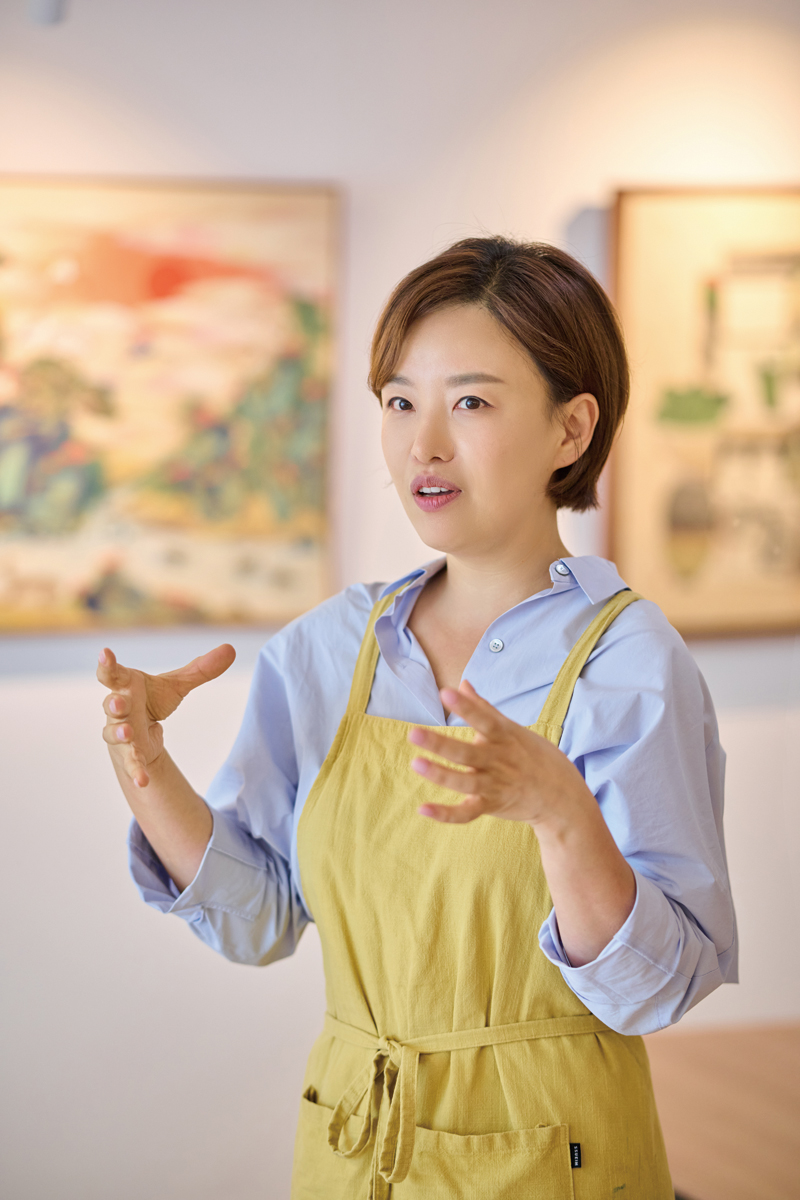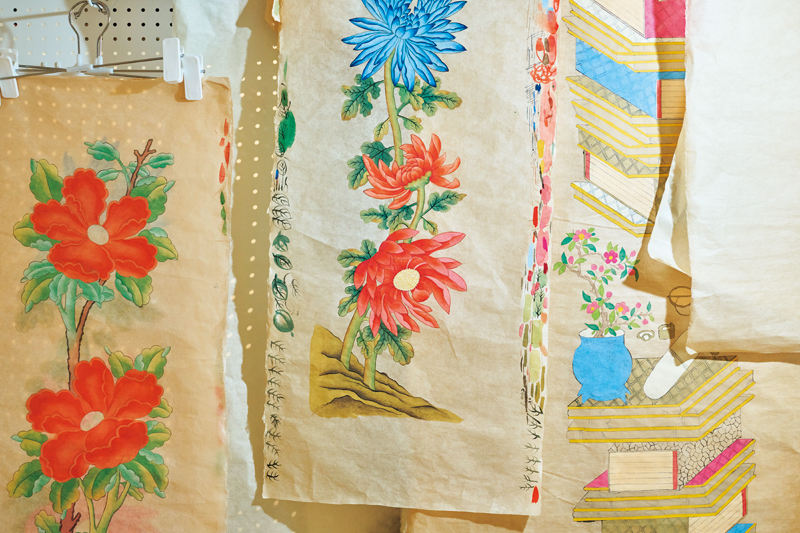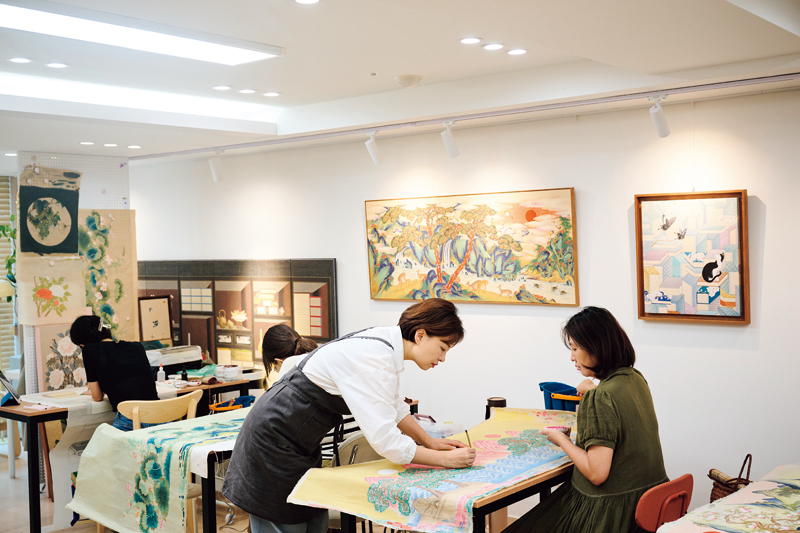Minhwa — Korean folk painting — remained somewhat obscure until the 1960s, when collectors and researchers took greater notice, sparking interest among the general public. These days, minhwa is a fairly widespread hobby, and its reach continues to grow through competitions, art fairs, and even gallery shows. Minhwa instructor Shin Sang-mi also started painting as a hobby, but she now runs her own studio.

Shin Sang-mi is enjoying her second career as a folk painting instructor.
Shin Sang-mi’s studio, bustling with eager students, is called Morihwa. The name is composed of the Chinese characters for worry (mo), leaving (ri), and painting (hwa), and thus means “a painting to disperse the worries of everyday life.” Here, people learn the art of minhwa.
Korean folk paintings originated during the Joseon Dynasty (1392–1910) and were mostly created by unknown artists without formal training. They produced works that were used to decorate the homes of common people, as signified by the Chinese character min, “ordinary people,” in the art form’s name. Minhwa is thus considered to be born amidst the people, made for the people, and circulated by the people.
LAYER UPON LAYER
For Shin Sang-mi, there are two types of days — three days a week she has classes, and on three other days she doesn’t. The remaining day is a day of learning.
On class days, she wakes up around seven and sees her daughter off to school before heading to her studio, a 69-square meter space near Gyeongbok Palace in the heart of Seoul. With her two dogs in tow, her daily commute takes about ten minutes.
“At first, I just gathered people from the neighborhood and taught them for free. About a year later, I decided to start teaching classes in earnest and opened my studio. The location near the palace is expensive, but people now come here from all over the country,” says Shin.
When she arrives, she plugs in her electric car and takes her dogs for a walk. Once she’s back at the studio, she puts on her apron, waters the plants, and prepares for her classes. The first one starts at 10:30 a.m. and lasts for three very full hours.
“I started with just five desks. Now there’s eight. I have about eight students per class and currently run six separate sessions. There’s even a long waiting list with people ready to join up as soon as a space opens,” Shin says.
In the world of minhwa, there’s no big difference between those who have studied it and those who haven’t. Most pieces are made with a drawing template of sorts, so people can choose what they would like to paint and concentrate on filling in the color. This makes it easy for amateurs to immediately get a feel for the art, and tends to guarantee a relatively solid and encouraging outcome.

While more experienced painters naturally create works of a higher quality, even beginners who take up minhwa as a hobby can achieve satisfying results.
“Creating minhwa is a process of rendering powdered paint into liquid and building up layer after layer of color. It can take several months to complete one painting, but if you apply yourself to it slowly, like practicing meditation, then you’ll find yourself wanting to keep at it. It’s a culture that anyone can enjoy. Everyone who comes to my studio is having a good time.”
Even without any special talent or skills, the amount of effort one puts in translates directly to better results. Time spent creating minhwa is also time spent in complete serenity and focus, a reprieve from the worries of daily life.
LIFE SIMPLIFIED
Before she became a minhwa instructor, Shin Sang-mi worked for 20 years at a major corporation, where she designed wallpaper, flooring, and furniture film. It was there that Shin had her first encounter with traditional folk painting.
“In the early 2000s, there was a huge market for jangpan [PVC flooring] in different colors and patterns. I wanted to design flooring with a pattern of minhwa butterflies, so I contacted a minhwa artist,” she says.
“I worked really hard at my job. Nobody asked me to, but I would even work on Sundays. Then, around four years ago, my child got sick, so I ended up turning in my resignation. Suddenly quitting the work I’d done every single day for decades was so stressful. My body, my mind… everything was a mess. I was like, ‘Well, this can’t stand; I need to go somewhere and draw a flower or something.’ That’s when I started learning minhwa.”
She enjoyed it. When she was painting, she was able to put aside her worries and burdens. During this period, she did nothing but eat and paint. And since there was a limit to the variety of minhwa she could paint at any one studio, she ended up frequenting three or four different places. Naturally, along the way, her skills improved.
“I’m not someone who can just stay home all day,” Shin says. “When I start something, I throw myself into it so completely that it can damage my health. I want to be praised, and I want to do a good job. When I took up painting, it gave me more energy — and I also had more time to take care of my daughter, so her health improved, too.”
What might have taken others a full decade, Shin managed to master in less than three years. One day, it occurred to her that she might be able to paint an entire folding screen. In just three months, she completed a project that usually takes an entire year. With that first painted screen, Shin won the first prize at the Grand Contest of Korean Minhwa Painting. This gave her the confidence to open her own studio and take on students.
Shin’s experience in the workplace proved valuable in establishing herself as a minhwa artist. After all, she had used combinations of red, yellow, and blue for twenty years as a designer of commercial products.
“I was specialized in creating colors. Minhwa has no set color palette, so the same painting can be executed with entirely different colors depending on the artist or studio. You find your own palette by experimenting with lots of different combinations. Many people think bold use of obangsaek [the traditional five colors of blue, white, red, black, and yellow, which symbolize the five cardinal directions] is what makes a work minhwa, but I tend to favor more neutral tones, called gansaek. Obangsaek pieces look great in traditional Korean houses, but I don’t think they really suit modern interiors. My folding screen for the minhwa contest was actually the most somber-hued painting in the whole exhibition. These days, I’m a bit obsessed with toned-down yellow and mustard.”
Every Tuesday, Shin attends a minhwa class taught by a master painter from eleven in the morning till five in the afternoon alongside ten or so others.
“On the day of the contest award ceremony, the elderly master artists were all sitting in the front row — one of them looked exactly like my father. So, I went up to him and said, ‘Please, take me on as your student.’ You see, each flower, each butterfly in a painting has a specific meaning. And as you paint, you start wanting to learn more about it. I now study with him every week; we take breaks in the middle to eat and have some makgeolli together, too.”
REWARDS FROM STUDENTS
On days without classes, Shin skips going to the studio.
“At first, I thought I should be doing my own painting here, too. But when it started to feel more and more like an office, I found myself wanting to go home. So, that’s where I work on my own paintings. Now that I have a studio and have become a teacher, my own works feel different. I try too hard, thinking they have to be excellent, so painting itself isn’t as fun as it used to be. Giving feedback on students’ paintings and seeing them improve — that’s actually much more enjoyable now.”
Shin’s students are mostly women in their forties and fifties. Spreading all their materials over the tables, their hands never stop moving as they chat about all sorts of things. Three hours fly by, and everyone relieves some stress.

A selection of works by Shin’s students. Although they worked from the same template, the pieces look entirely different, due to each artist’s taste and color choices.
“When I’m working on my own, my mind is quite literally empty. Often, on my days off, I’ll while away the hours doing this and that, and only get started in the evening — but then I’ll blink and it will be close to dawn. My mother is in her seventies, but she’s one of my students now, too. Anyone can do this, regardless of age, and the amateurish quality of beginner pieces is true to the flavor of minhwa,” Shin says.
Her students’ happiness is her reward, a kind of joy she had not experienced in the corporate world. Despite staying up until three or four in the morning, barely getting any sleep or eating on days when she has nine hours of classes, she is grateful for everything, for the new path she’s found and for the people who come a long way to learn from her.
“My father passed away not too long ago. Right now, I’m working on a painting for him. Using blue and my favorite mustard yellow.”